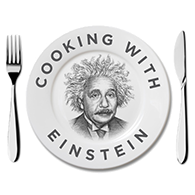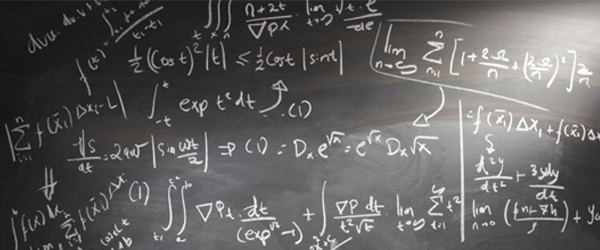

“Gravitation is
not responsible
for people falling
in love.”
Albert Einstein
1933
Trust me, it's really not that hard.
Equations and formulas are simply symbolic notation, where letters and symbols represent the components of a thing. H2O is the commonly understood formula for water (two parts hydrogen to one part oxygen). Writing it as H2O saves 34 keystrokes and puts it into a language that allows it to applied to a number of formulas in a multitude of scientific disciplines.
We’re going to do the same thing but instead of solving the problems of the world through science, we’re going to cook lasagna (or meatballs or whatever you’re hungry for).
Understanding math is like looking at a totally foreign language like Japanese or Arabic, where the symbols give no clue to pronunciation much yet meaning.
If you want to learn to read these, you need to learn new symbols, new words and new grammar. It’s the same with Cooking With Einstein, you also need to learn new symbols (like π for chop, θ for blend and Σ for dice) and new grammar (writing formulas in a logical and consistent manner).
Part of understanding the formulas is understanding the symbols. You need to learn what each of the symbols are and what they mean. And we have a link to the basic symbols for ingredients, actions and application of heat that you can reference to understand the formulas and make your own.
You also need to concentrate on the new vocabulary of symbolic notation and take note of the “math grammar” — the way that it is written and how to understand the sequence of steps in the formulas. You don’t put the onions in last when making a red sauce. You need to be able to read the formula correctly.
A little bit of effort on learning the basics will produce huge benefits.
Panakuken, the traditional way.
This is an easy recipe for making a great Sunday breakfast pancake.
Cooking With Einstein Panakuken.
The first step is to collect the symbols that represent the ingredients, heat and
actions for whatever you are cooking. For Panakuken that is:
Panakuken
egg
flour
milk
nutmeg
butter
mix
melt
bake
pinch
Directions:
Preheat oven to 425º
Mix all ingredients except the butter.
Melt the butter in a heavy oven-save skillet.
Add mixture and place in hot oven for 15 minutes.
Ingredients:
2 eggs, mixed
1/2 cup flour
1/2 cup milk
pinch of nutmeg
4 tbls butter
Cooking With Einstein
©2014 The Kenyon Consortium, LLC
All Rights Reserved
Now let’s build the separate functions from the recipe.
2 eggs mixed is a step, so consulting our symbols list we place them into parentheses:
(2Efwml)
Next we need to combine 1/2 cup of flour with 1/2 cup of milk. This function goes into parentheses as well:
(0.5cEfw•0.5cEmk)
We will then need to indicate the pinch of nutmeg:
Hanwpn
Since these get added together it is written like this:
(2Efwml)+(0.5cEfw•0.5cEmk)Hanwpn
The four tablespoons of melted butter is a function:
4TbsEbsml
Finally we need to indicate the heat , in this case 15 minutes in a 425º oven,
with the oven symbol and the proper notation:
Now we start building. The action of the melted butter is the denominator and the combination of the other ingredients is the numerator:
(2Efwml)+(0.5cEfw•0.5cEmk)Hanwpn
__________________________________
4TbsEbsml
Now let's put all these functions into the heat source and we are done:
As simple as that.
425º
0:15
425º
0:15
2Pan =
(2Efwml)+(0.5cEfw•0.5cEmk)Hanwpn
4TbsEbsml
